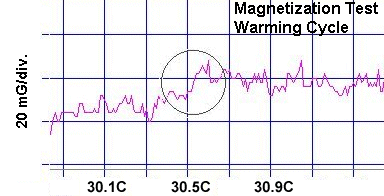
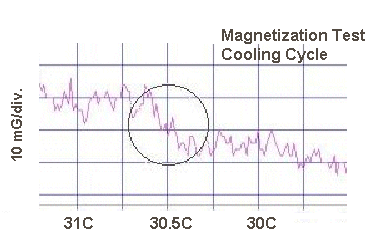



Superconductors.ORG herein reports the 28C room-temperature superconductor discovered in December 2011 has been successfully reformulated to produce a critical transition temperature (Tc) above 30 Celsius (86F, 303K). This new material has a nominal formula of Tl5Pb2Ba2Mg2.5Cu8.5O17+ and a Tc near 30.5C. The target structure remains a D223.
More than a dozen magnetization tests were performed on the test pellet to confirm this extraordinarily high Tc, due to its low volume fraction and high noise figure. The test results ranged from 30C to 31.5C. The highest and lowest measurements were discarded and the remaining results averaged, producing a mean Tc of 30.56 degrees Celsius (mid-point). The flashing lines in the two plots at page top represent the average of the noise component skewing apart at 30.5 C in both warming and cooling test cycles.1
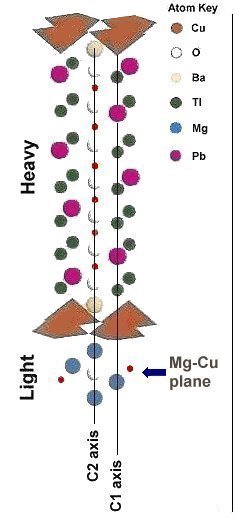
|
The challenge of increasing the Tc of the 28C material was considerable, since its c-axis unit cell length was already near 33 angstroms - an upper limit discovered experimentally. Increasing planar weight disparity (PWD) along the c axis by adding more thallium and copper suppressed the superconductive state altogether. However, PWD could successfully be increased by substituting another magnesium atom into the light region of the D223 structure - so long as a copper atom is positioned adjacent to it on at least one side. This was accomplished by placing copper in the a-b plane using 2.5 Mg atoms and 8.5 Cu atoms in the stoichiometry. This creates a sheet with a 50-50 mix of Mg and Cu (see arrow in graphic at left). An attempt to use all magnesium in the "Light" region failed to produce any signs of superconductivity.
As an adjunct to this discovery, several plots displayed
a visible drop in RMS noise below Tc. This phenomenon has previously been observed in VHTC
superconductors with a high noise figure. In the below graphic, test "1a" has had its DC component removed
to highlight the observable reduction in noise below Tc. This suggests strongly that phonon mediation
is at work in these materials. To read more about this phenomenon
CLICK HERE.
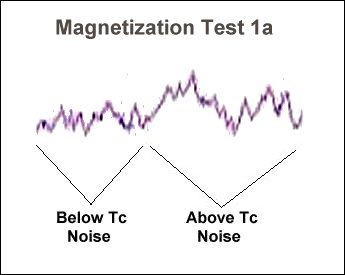
|
Dots have been placed within the C1 plot below, depicting where D223(Mg2.5Cu8.5) lies relative to the other high performance thallium copper-oxides. Temperatures plotted (in Kelvin) are resistive. Even though the PWR-v-Tc has not increased along the C1 axis, in this formulation the C2 PWR has increased by over 60% (C2 graph not shown).
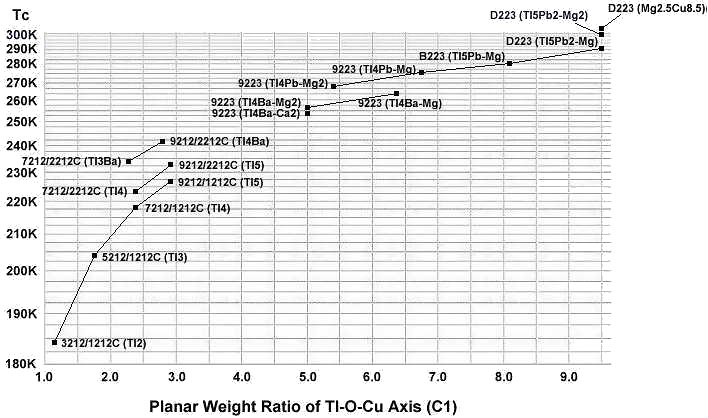
Anecdotally, the test pellet appears harder than previous formulations, likely due to its higher magnesium content. And since the volume fraction is theoretically lower than its 28C prototype, more layers are required to synthesize a detectable amount. Tl5Pb2Ba2Mg2.5Cu8.5O17+ must be prepared using the layer cake method, as shown below. The pellet had approximately 105 interference layers. And, even using this technique, the volume fraction is low, requiring very sensitive test equipment.
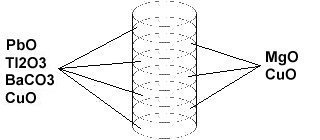
The below stoichiometric ratios were used for the ODD layers:
Tl2O3 99.99% (Alfa Aesar) 7.366 grains...and the below ratios for the EVEN layers.
MgO 99.95% (Alfa Aesar) 2.60 grains (4x stoichiometric)The chemical precursors were pelletized at 70,000 PSI and sintered for 34-35 hours at 865C. The pellet was then annealed for 10 hours at 500C in flowing O2. Temperature was determined using an Omega type "T" thermocouple and precision OP77 DC amplifier. The magnetometer employed twin Honeywell SS94A1F Hall-effect sensors with a tandem sensitivity of 50 mv/Gauss.
RESEARCH NOTE: The copper-oxides are strongly hygroscopic. All tests should be performed immediately after annealing.
RE-PUBLICATION NOTICE: Elsevier Publishing, dba Elsevier Science, as well as Morris Communications, both print and broadcast divisions, are specifically prohibited from re-publishing any part of this news story.
E. Joe Eck
© 2012, 2013 Superconductors.ORG
All rights reserved.
1. Testing temperatures are believed accurate within +/- 0.40 degrees C.
 BACK to "News" page at Superconductors.ORG
BACK to "News" page at Superconductors.ORG